Home › A-Z Diving › Dive Gear › Scuba Mask › Reviews
Best Dive Mask for Beginners
You can buy dive masks in a range of different styles and colours. But, the most important feature is that it allows us to see things clearer underwater.
The following information, evaluations, and customer reviews will help you choose the best mask for beginners and what makes a good diving mask for divers and snorkelers.
What's the Best Dive Mask for Scuba Diving
There is no benefit in buying a cheap mask if it feels uncomfortable or it lacks a good field of vision.
Still, go ahead and test the soft nose pocket. Make sure you can pinch your nostrils for equalisation underwater.
Then, a good dive mask is one that makes it easy and simple for divers to clear water from it.
So, having tested a range of different scuba masks, you can base your final decision on its design and colour.
The list of best scuba diving masks that we reviewed below is a helpful guide. We have not based it with any particular bias towards specific models. Please send an email to our team of scuba professionals if you have any questions or comments.
Some of the Key Factors We Tested
The team at Private Scuba in Thailand were happy to test and evaluate different makes and models of dive masks with a range of prices (cheap to expensive).
Overseen by our PADI Master Instructor, the testers based their scuba mask reviews on the following factors:
Ease and Integrity of Adjustments
Is it easy to adjust the buckles and strap and does an adjustment actually meet the objectives? It's also important to confirm whether they stayed in the chosen position after making the changes.
Mask Volume and Dryness
After flooding the mask with water (intentionally) the testers evaluated how easy it is to completely clear a flooded mask, including:
- How easy is it for a beginner to pinch their nose through the soft nose pocket for equalisation?
- Overall, did the skirt seal and strap assembly do its job properly and keep water away from the diver's face?
Field of Vision
Being able to see underwater is the main reason for divers to wear a scuba mask. So, we checked the field of view in all directions (to the left, right, up, and down).
Not only did we check if the frame or skirt blocked the view, we used the results in comparison to other masks that we reviewed?
General Comfort Rating
Several key factors can make it a good mask for scuba diving and snorkeling. Here are three important questions to answer before you buy a scuba mask - especially if you are beginner:
- Is the skirt made from silicon and is it flexible, comfortable, and soft on your face?
- Can you squeeze the nose pocket easily in preparation of pinching your nose to clear it?
- Do any of the components, especially the frame, rub against your face and do you feel pain on your cheekbones or nose?
Note: Our dive mask testing included a rating about construction (e.g. design and ruggedness) and its resistance to fogging. Even so, being based in Asia means we did not test scuba masks on a comprehensive range of face sizes and shapes (i.e. a professional review of mask comfort and dryness is somewhat subjective).
Promate Ocean Owl Mask Review
If you are a beginner looking for a diving mask that balances comfort, seal, and clarity, the Promate Ocean Owl MK160 is worth checking out.
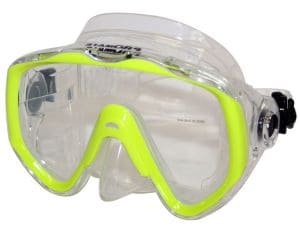 For many users, this is the best rated dive mask on the market, and you can buy it for less than 1,000 THB ($31).
For many users, this is the best rated dive mask on the market, and you can buy it for less than 1,000 THB ($31).
However, there's one important feature you need to be aware of.
Generally, it provides a comfortable and snug fit. But the extra wide field of view is unlikely to match everyone's cheek bones and facial structure.
Yes... The Ocean Owl diving mask enjoys strong reviews from real users - especially those needing an oversize lens and big skirt.
But, it ranks best among divers and snorkelers who've been struggling to find a mask that accommodates individuals with large faces. The general feedback from people who buy spearfishing equipment is also quite positive.
Key Features and Description
- The extra wide and long lens offers an incredible field of view and is best suited for "big-headed" divers.
- Double edge comfort seal, low volume, and tempered glass (made in Thailand).
- Weight 0.75 pounds and available in black, blue, clear, or yellow.
- It has an oversized skirt for extra comfort with a crystal, liquid silicone injected skirt and strap.
- The quick release swivel buckle design allows for easy removal of the mask strap and you have options for inclinations in various angles.
Customer Reviews and Comments
"I'm a new diver with a large head and I think it fits really well. I find the seal comfortable and soft to the face, with plenty of room for adjustment."
Mares FORCE-X LS Mask Review
The well-known Italian diving mask manufacturer may have released the best scuba mask so far with the Mares Force‑X LS LiquidSkin model.
It's true to say a range of top-tier features and the softness of the adaptive bi-silicone skirt combine well with broad peripheral vision underwater and a balanced strap system.
In addition, one of the coolest features is the easy lens customisation facility. These elements are helping to position it as one of the top choices for divers looking for versatility and minimal facial pressure.
Key Features and Specifications
- The new LiquidSkin bi‑silicone skirt structure combines firmness with ultra‑soft comfort (around 45% softer*). The adaptive seal suits a wide range of face shapes.
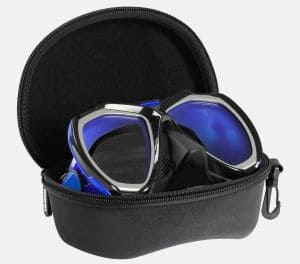 An integrated stainless‑steel frame and flat profile help to deliver enhanced panoramic vision durability.
An integrated stainless‑steel frame and flat profile help to deliver enhanced panoramic vision durability.- The Y‑shaped buckle system distributes strap tension evenly around the face. This helps to improve comfort and reduce facial pressure.
- One key advantage of the quick-release metal lens clips is being able to change the lenses yourself. The tool-free system means you can easily install prescription or tinted lenses.
- The Mares FORCE-X scuba mask is packaged in an eco‑friendly reusable Ethylene Vinyl Acetate (EVA) storage box to help reduce single-use plastic waste.
Pro Tip: Not only is the Force-X mask suited for divers who enjoy extended submersions, it's also a safe way of "scuba diving with glasses" because you have the flexibility to swap to prescription lenses.
User Reviews Mares FORCE-X LS Scuba Mask
"I've read many diving mask reviews and I know how it helps learners. I like to make multiple dives in the same day and my new Mares mask was just as dry on the last dive as it was on the first. One of the most comfortable I've ever worn."
XDEEP Radical Diving Mask Review
There are several important features that all the best dive masks share - especially comfort and fit. As a consequence of that, the super-soft silicone skirt of the frameless XDEEP Radical scuba diving mask helps to deliver exactly that.
Because it conforms to most face shapes and sizes, it gives a close and watertight seal without a feeling of excessive pressure.
A 'radical' redesign of the nose pocket results in a large area to pinch during equalisation. This is extremely important for divers who wear thick dive gloves (e.g. on cold-water deep dives).
The new XDEEP dive mask also has a wide field of vision. In fact, an expansion in the lens area broadens the panoramic view and it helps to minimise blind spots.
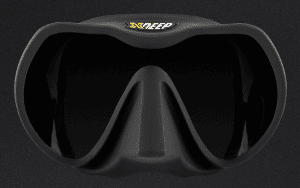 Key Features and Specifications
Key Features and Specifications
- 3D modelling provides a frameless mask with the softest silicone. The outcome is unparalleled comfort with minimal facial pressure.
- Equalisation and mask clearing is easier for beginner divers, thanks to the enlarged nose pocket and low internal volume.
- The wide panoramic view offers a huge improvement in situational awareness.
- The glove-friendly design makes it easy to grip and handle in cold water or technical gear settings.
Pro Tip: A lack of iron oxide means the ultra-clear glass is void of a green tinge often seen in many of the cheapest masks for scuba diving.
Customer Feedback about XDEEP Radical Diving Mask
"For me, it fits my facial profile to perfection. There are no major issues with fogging - even when I don't use any commercial mask anti-fog products or toothpaste."
"Even though the overall design is similar to most frameless masks, this one from XDeep is one of the coolest. It's super comfortable and I get a large field of view underwater."
SEAC Reverse Dry Snorkel Review
As part of our snorkel mask reviews we wanted to point out some of the key features of the popular SEAC Reverse Dry Snorkel.
It's versatile, feature-rich, and it does a very good job of combining user comfort with functional Dry‑Top protection.
Scuba divers will find the purge valve efficient with extra comfort from the adjustable latch. Ambidextrous mounting, ease of surface breathing, and a price tag of around $37 (1,200 THB) means the Reverse Dry Snorkel is also ideal for anyone learning snorkeling.
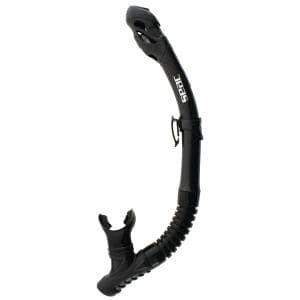 Key Features and Specifications
Key Features and Specifications
- The Dry‑Top valve and shroud help to prevent water from entering the tube, even when it's fully submerged.
- Silicone mouthpiece is ergonomically designed and soft. It reduces jaw fatigue and the user can rotate it to either side (e.g. using a mask‑clip on the left or right).
- Corrugated lightweight tube section allows flexibility to swing the snorkel away from the face (comfort and regulator interference reduction).
- The purge valve below the mouthpiece contains a poppet valve (often called a mushroom valve) to provide quick drainage of water through exhalation.
- Having a quick‑release clip means you can easily attach these SEAC snorkel tubes to their range of dive masks.
- Various colour options include black and red, black and orange, clear (aqua), and a black with lilac combination to match other SEAC gear and scuba products.
Customer Comments about SEAC Reverse Dry Snorkel
"I'm not really into scuba diving, but I bought one of the SEAC snorkels to try out on my recent holiday in Thailand. In truth, I found it quite heavy and it wasn't super easy to breathe through."
SEAC Symbol Mask Review
To begin with, we wanted to determine the unique selling point of the new Symbol scuba mask. In fact, the main benefit is being able to change the standard lenses for prescription lenses.
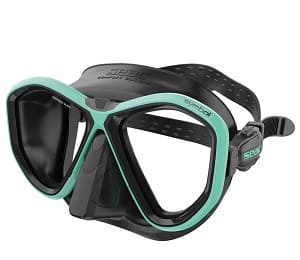 Hence, because you can't go scuba diving with glasses, being able to swap a tempered glass lens without having to buy a new dive mask is really handy (e.g. if you break a lens).
Hence, because you can't go scuba diving with glasses, being able to swap a tempered glass lens without having to buy a new dive mask is really handy (e.g. if you break a lens).
The sturdy frame holds the twin lens design together. There are tiny recesses around the internal frame that allow you to pop them out.
Seac Symbol dive masks also allow you to fit your own prescription lenses. So, you can have two different lenses to match your specific needs.
The new SEAC Symbol scuba mask is available in seven (7) different colours, including the traditional black colour.
The detailing on the nose pocket adds a certain amount of grip to ease equalisation. The 3D buckles do not attach to the frame - so you can fold it completely flat (e.g. for safe storage).
Key Features and Specifications
- Angled 3 mm thick tempered glass lenses (replaceable)
- Curved skirt edge (silicone)
- 3D strap buckles
- Double-button 3D rocker buckle
- Twin optical lenses for myopia or presbyopia
Pro Tip: Most manufacturers of scuba masks have started using eco-friendly cardboard boxes (instead of plastic).
Customer Comments about SEAC Symbol Dive Masks
"Cheaper copy of Tusa Intega, which also allows prescription lenses."
"A guitar pick is a great tool for separating plastics like you're talking about to change the lens. If you need to, grind one corner down a bit to make it closer to the appropriate screwdriver size."
Seac Icona Mask Review
The silicone of the new frameless, single-lens, two-tone, dive mask made by Icona bonds directly onto the tempered glass.
Besides the subtle flash of colour around the mask, the matt skirt also has a smooth, non-reflective finish on the inside as well as the outside.
Plus, the 'rounded' edge of the skirt increases grip and helps to prevent those annoying dive mask marks on your face (e.g. after making a long dive).
Key Features and Specifications
The Seac Icona dive mask features new 3D hinged buckles with a two-button ratchet strap mounted into the silicone skirt. The result? It creates a better fit, reduces the risk of unzipping itself, and it packs flatter for storage.
![]() First, you may notice that most scuba mask manufacturers have started using eco-friendly cardboard boxes (instead of plastic).
First, you may notice that most scuba mask manufacturers have started using eco-friendly cardboard boxes (instead of plastic).
Next, another noteworthy feature of the new Seac Icona mask is the reduction in internal volume - mostly due to the lack of clunky framework.
In general, less internal volume means the process of equalizing pressure while diving becomes somewhat easier (because it sits closer to your eyes).
Furthermore, the new 'curved' skirt design opens out the field of view and allows lots of light to penetrate through the glass.
Customer Comments about Seac Dive Masks
"SEAC is an Italian company and they offer good sets with top quality snorkels and comfortable masks for beginners. But it's a competitive market and for those who want to scuba dive even more or want better quality, I do recommend purchasing snorkeling equipment separately."
"For those who just want to get out there and need the basics and don't want to spend all that much, then the SEAC Frameless Scuba Snorkeling Snorkel/Mask Set is worth checking out!"
Tecnomar Pro Ear Diving Mask
Most divers will have heard some good and bad reports about the IST Pro Ear diving mask. The design and unique features (tubes and earmuffs) help to compensate for the air volume between the eyes and ears.
Key Features and Specifications
It's not uncommon for beginners to struggle with equalisation problems underwater (e.g. ear issues). Thus, if you have similar challenges, the IST ProEar Mask could be a perfect fit for you.
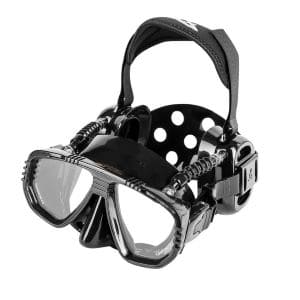 In general, it offers a comfortable fit around the face and there are two (2) ear protectors at the sides.
In general, it offers a comfortable fit around the face and there are two (2) ear protectors at the sides.
The earmuffs fit over the diver's ears and the tube system works by automatic process as the diver exhales.
- The unique tube and seal system automatically equalises ear pressure as the diver exhales into the ProEar mask.
- Its design can prevent pressure-induced ear barotraumas (MEBT).
- There is some evidence of enhanced underwater hearing and an improved sense of direction.
- Having watertight ear cups means it can keep water out so your ears are warm and it can help to prevent infection.
The manufacturers of the ProEar say it helps to prevent inner-ear infections. Furthermore, it helps divers avoid severe pressure injuries. The prescription-lens option is now available and you can wear a neoprene integrated hood with this mask.
Customer Reviews about the Pro Ear Mask
"The materials are good and it is comfortable to wear, it can even be worn with a hoodie, but it's somewhat more uncomfortable."
"I took the Pro Ear mask for a trial dive in a pool first and it worked perfectly... it kept my ears dry perfectly. The following morning I tried it out for a real dive.
It was rather hard to put it under my hood (loose hood). It will work fine with a wetsuit and integrated hood. The anti fog function was 'OK'!
Visual area was smaller as what I would expect, silicones sides could be a bit more softer / flexible to better lock off water inlet in the mask, but at the end of the day it still kept my ears dry for the full 62 minute dive."
Related Information and Help Guides
- Accessories and Gadgets for Divers and Snorkelers
- Can You Wear Glasses while Scuba Diving?
- Scuba Equipment Maintenance and Post-dive Care
Note: The short video presented by PADI® shows how to clear a dive mask without getting water inside your nose.